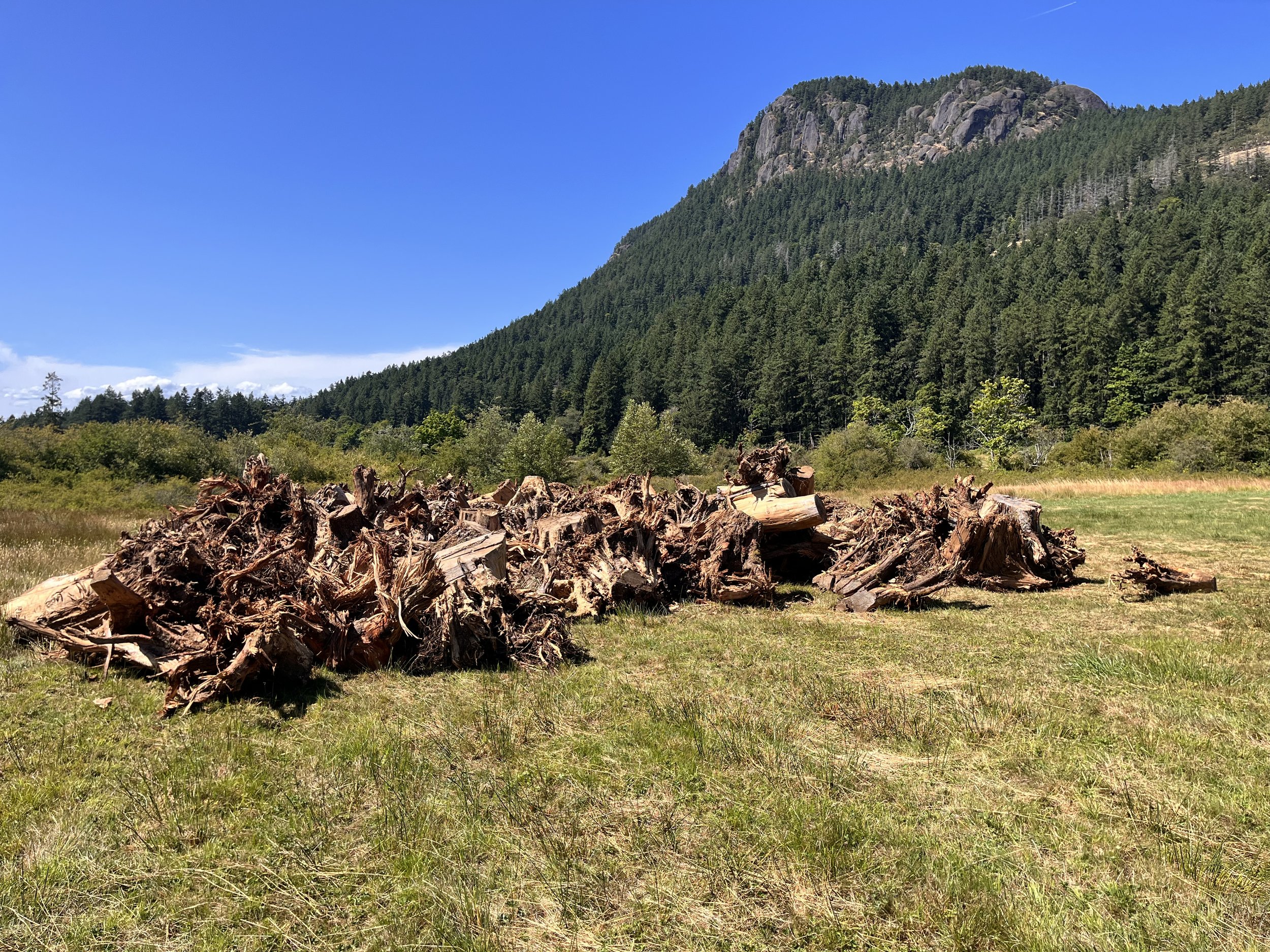Coarse Woody Debris comes to Xwaaqw’um
Stqeeye’ has been collecting donated stumps and chips to use in the upcoming wetland restoration work this fall. Coarse woody debris (CWD) are large pieces of wood such as stumps, logs and heavy branches. This type of organic matter is added to wetlands during construction to provide stability to the substrate, to store water and create shady habitat for wildlife, birds, amphibians and fish. This is a key part of wetland creation, as the large stumps anchor the muddy substrate and give some natural dimension to newly created pools. They also fast-track the creation of carbon-storing woody mass in the soil, which over time, will maximize carbon storage in Xwaaqw’um.
Robin Annschild, the Wetland Restoration Expert at Xwaaqw’um worked with BC Parks in 2018 to create a Wetland restoration plan that incorporates the Burgoyne Bay Provincial Park Management Plan objectives from 2015 “Logs, branches, root masses, and leaves may be placed in the restored wetlands to improve habitat for a diversity of plant and animal species. Branches of various diameters and lengths may be placed in the wetlands to provide egg attachment sites for amphibians, and improved habitat for invertebrates, and plants. Branches and logs that have broken off, not cut with a chainsaw, should be placed in the restored wetlands. These would look natural and provide improved habitat for wildlife compared to trees cut using a chainsaw. Large woody debris would be anchored by burying approximately one-half of each log in the soil.”
Logs placed in wetlands also provide loafing sites for waterfowl, shade and landing sites for butterflies and birds, and retain moisture around their base. Newly planted Western Cedar trees at Wetland 1 have shown to be the tallest and most robust planted trees as compared to those planted out in the open away from stumps.
Since Carbon is the buzz word of our time, we have been learning so much about carbon for our Nature Smart Climate Solutions Carbon Sequestration grant fund and workplan. Our approach is two-fold. Coarse Woody Debris (CWD) has been diverted from operations where it would otherwise be burned causing Green House Gas (GHG) emissions. Then it is added to the restored areas to sequester Carbon and offset further GHG emissions. CWD will be stored, accumulate, and persist over many decades as found by Paustian et al, 2019. Much of the CWD will be saturated with water thus decomposition and Carbon emissions will be prevented.
Enhanced management methods will optimize landscape Carbon sequestration and storage capacity by looking for areas to add wood to Xwaaqw’um, because so much was removed in historic logging. We also will be working to protect currently stored Carbon stocks in the soils and forest. And Finally we are looking to increasing sequestration potential and reducing short-term Carbon loss by saturating the old fields that were previously wetlands.
Stqeeye’ is very excited to be able to add so much Coarse Woody Debris to the project areas. This meets the goals of reestablishing thriving balanced wetland habitat and sequestering Carbon in one action.
Further reading:
Paustian K, Collier S, Baldock J, Burgess R, Creque J, DeLonge M, et al. Quantifying carbon for agricultural soil management: from the current status toward a global soil information system. Carbon Manag. 2019 Nov 2;10(6):567–87.
Rumpel. CNRS Sonbornne University, Paris France. Understanding and fostering soil carbon sequestration. No 121. Burleigh Dodds Science Publishing. 2023.

